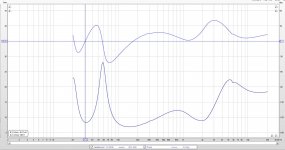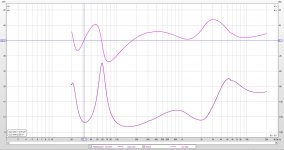The size of your tweeter is going to focus (beam) the treble. This means that the response will change depending on your listening angle. It means that room interaction may be reduced and also that cabinet interaction and subsequent diffraction and further room interaction may be reduced.
It also means that the overall treble (the sound power entering the room) will be reduced relative to the midrange if you tune the response to be flat on axis, due to the relatively reduced off axis response. This can be altered (possibly improved) if you tune the response to be flat at some off axis angle and listen there, making the sound potentially harsh if you listen too close to 0 degrees.
Harshness is sometimes a product of too little upper midrange followed by greater treble.
It also means that the overall treble (the sound power entering the room) will be reduced relative to the midrange if you tune the response to be flat on axis, due to the relatively reduced off axis response. This can be altered (possibly improved) if you tune the response to be flat at some off axis angle and listen there, making the sound potentially harsh if you listen too close to 0 degrees.
Harshness is sometimes a product of too little upper midrange followed by greater treble.
The nature of the lobing that results from sound that is produced by a large radiator is that the off axis pattern is not consistent with frequency (there are minor lobes at the edges).The tweeter's sound that is headed towards the ceiling is from a very steep off axis angle, so there's a lot of attenuation towards high frequencies.
This shouldn't be a problem if the drivers are closely spaced, and crossed so that they are not interacting out of the intended band. It is easier when the crossover frequency is reduced. Otherwise the lobing related to the positional discrepancy can cause problems such as inconsistent off axis response vs frequency, maybe making for problematic ceiling reflections as well as issues of balance through the upper midrange.Also the tweeter's sound has to go through the "soundfield" produced by the woofer, so there probably is some cancellation before the tweeter's sound can reach the ceiling and reflect to the listener.
Last edited:
You should be able to check the actual tuning frequency with the impedance measurement. See if it is really 34Hz. The tuning frequency is the mid point between the two impedance peaks (and should also be the point where the phase crosses zero).
Tony.
By phase crossing zero, do you refer to impedance phase? In that case the tuning frequency would currently be 31,3 Hz for the right speaker and 31,1 Hz for the left one. That would make sense, for stuffing can enlarge the effective cabinet volume easily by 10 %, or even more, if I've understood correctly. There probably is a slight difference in the amount and/or placement of stuffing between speakers, causing the difference in tuning frequency.
31 Hz tuning with the current port length of 12,3 cm and port diameter of 43 mm would mean that the effective cabinet volume is 28 liters.
Impedance measurement graphs for the right and left speaker are attached.
Attachments
Yes the impedance phase. As you can see the zero crossing point does not appear to be exactly in the centre of the dip between the two peaks, so if you were to base it on eyeballing that you would get a slightly different tuning frequency. I suspect however it is the midpoint between the two peaks, it is just that the dip is not 100% symetrical.
edit: for your own info it is probably worth doing the sim with the lower tuning frequency to see how that affects things.
Tony.
edit: for your own info it is probably worth doing the sim with the lower tuning frequency to see how that affects things.
Tony.
Last edited:
- Status
- This old topic is closed. If you want to reopen this topic, contact a moderator using the "Report Post" button.

